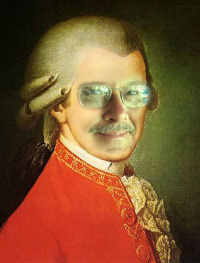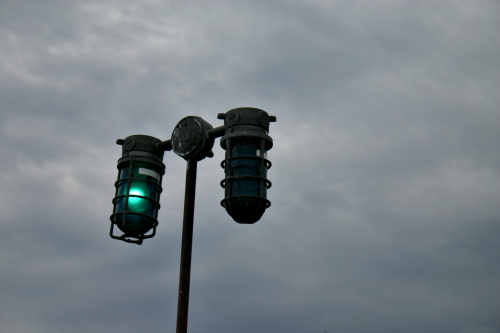A 365-Day Project
"We Are All Mozart"
A project to create
new works and change
the perception of the
music of our time.


 September 3, 2006
September 3, 2006 
A few quick thoughts tonight that have been hanging around. First, a letter from Ann Cantelow that responds to my question about the time of the theremin.
|
Well, I don't think its time has come and gone!! I'm still composing for it, and doing lots with quarter-tones, (or at least repeatable fractions of tones, still settling in to these differences from traditional). I'm finding lots of unexpected power in melody that's unleashed from the 12-tone limit. It's more than a little exciting. I'm trying a longer piece now, maybe as much as a 20-min (longer time length being tried due to that recent discussion of piece length on CEC) piece inspired by a friend's sculptures, which are in turn inspired by aspects of Japanese culture. It happens I've been watching a series of lectures recently about history of the rise of the impressionist painting movement in France. I've been struck by discussion of "power" in paintings. I can see the young impressionist painters and their new painting culture pumping as much "power" into their paintings as they could, with all their might, be it with strong colors, or a new bringing out of daily life subjects that had never been seen before, or what have you. Van Gogh certainly implemented power in spades, wow. |
Ann is right. The reality is that the theremin is still here, and finding more and more opportunities for performances. My thought was poorly framed, perhaps. By its time having come and gone, I meant that it had an initial opportunity that was ruined by Termen and Rockmore, and now has entered a kind of fad status. Those of us who write for it and perform with it outside that faddish environment will likely continue to do so, but perhaps once the fad subsides, it will not rise beyond what was left of it before, in 1995, Bob Moog made it possible to own one easily.
The Other Side
People have asked why, as a contemporary composer working frequently in electroacoustics and who does his music production in software, I spend so much time in these commentaries talking about the natural world -- flowers and gardens and oceans and lakes and skies.
My reality is divided. Technology is the other side of my work, and sometimes it is far too pressing. For example, you can find me at RFID Update or as the author of corporate supplements and books on technology and the arts and articles on category management, supply chain, networking, computer technology, and company profiles.
My time is occupied doing this accessibility consultancy as well. A few days every month I also work with the Vermont Alliance of Independent Country Stores, and for a number of years ran a computer business for which I designed hardware and wrote software. All the websites are coded by hand, I maintain the Color Computer listserv, and design sites for other composers such as Thomas L. Read.
Add in the fact that even my artistic work from music to photography involves digital tools and their maintenance, and that for 15 years I repaired electronics for Morel Electronics, and you've got a life that -- despite its presence in rural Vermont -- is replete with technological pressures.
So. Whenever I can get out of the technological mindset, whether it's rethinking the future or collaborating on a novel or hiking the southwest and then writing about it, I am delighted to do that. If I can get out in the garden or go out on the water or even roll in the snow (my version of skiing), so much the better.
Something has to set my mind at rest.
Why Do They Do It?
One of the greatest exasperations composers have once they step out of the musical niche where they are welcomed is the continuing misunderstanding and hostility that greets the very idea of new nonpop.
Just when it seems that a positive change is underway, evidence appears to contradict that assumption. Part of my recent commentary on the theremin began life as a listserv post that morning. In response came to that post came this:
Damage shmamage! This so-called "damage" you refer to, that was apparently done by that misguided duo of Leon Theremin and Clara Rockmore, is damage that you yourself have dreamed up and that has been done to a musical dreamworld that is likewise of your own fabrication. As such, I accept that to you it is as real as the air you breathe.
The response is staggering. He cannot imagine a world in which a new instrument is actually greeted with new developments, developments which Termen and Rockmore failed to work out or even encourage. Film started out replacing painting, and in the hands of a few people the two became mutually transforming (such as Mathew Brady and Winslow Homer), and then photography quickly moved on to establish its place in the culture. Early movie dramas and comedies emphasized the stage, and replicated it on film -- until D. W. Griffith introduced the stage-impossible spectacle and Sergei Eisenstein's Battleship Potemkin showed us the fearful power of montage and effects. Radio was newspaper in sound until the radio drama and on-the-scene news report pulled it quickly away from its print cousin. Television was visible radio until just a few years could expose its flexibility as a unique visual medium.
New materials beget new ways of working. The typewriter is gone, even if the keyboard layout remains hinged to the past. The fountain pen is gone. The record player, the tape recorder. The dial phone, the road without sidelining, the pressure cooker, the icebox, the oil lamp. Though all may still function, and though we may retain characteristics that remind us of their heritage, each succeeding generation of change lets history overtake and overwhelm the habits and technologies of the past until the old technologies exist only in museums.
Kevin Austin reflected on it this morning; for the full thread, composers reading may wish to join the CEC Conference:
In the late 40s Hugh le Caine built an instrument somewhat more advanced in some respects than the Ondes Matinot, the electronic sackbut. It has many possible ways of making sounds, but in his own demonstrations, he demonstrated it as another extension (into the electronic domain) of the european tradition of instrument design and invention. The piano had been a soft/loud harpsichord -- it's possible development not being foreseen. [...] I have yet to meet anyone who can hear a sound solely for its original quality. I treat this as an urban myth of the musique concrete school. At some time, this myth may be accepted as just that, a myth, but it is against the nature of myth to be examined too closely, being a belief system.
The inability to "hear a sound solely for its original quality" -- that is so similar to the previous writer's inability (and Termen's inability) to hear music for its original quality vis-à-vis a new instrument. Austin is being relative, of course, but in the nonpop music world, originality is treated as a cancer. The original quality must be cut away in the air or in the mind. Its existence must be condemned as a "dreamworld", a dark place for the damaged spirit, for otherwise it would be a threat to the precarious nature of artistic belief.
How did music become the singular artform in which unflowering failed, in which the blooms continued to die as buds? Just think of the analogies in time. Were nonpop behavior to infect the other arts, playgoers would flock to King Lear because Death of a Salesman troubled them -- and they would run screaming from the very existence of The Pillowman. Yes, it works for the comedies, too. And speaking of comedy, these parallel audiences would want standups to perform The Wife of Bath's Tale more than they could enjoy the cynical Mark Twain, and prefer the exploits of Twain to knee-slapping at Rita Rudner. Film, radio, and television would hardly get a passing glance, what with the byways full of jongleurs and street organs and 24-hour Punch & Judy shows. Picasso and Pollock and Warhol would have toiled in obscurity in favor of Elvis on black velvet and big-eyed children and cats ... oh, wait, that almost did happen, at least the big-eyed Elvis part.
But you get the point. The artform that nonpop audiences and performers find most significant to their lives was gone, vanished, dead for decades and centuries before their birth. To say that is not some aberrant conclusion drawn from a "dreamworld." It is the revelation of pathological behavior. We have tried to succor audiences out of their own dreamworld of the past through invitation and education. But invitation and education do not cure what ails them. Perhaps instead we should acknowledge this pathological behavior, and seek not an inducement but rather the means to a cure. Shock therapy all around? Something Clockwork Orangey, perhaps?
You bet it's late.
